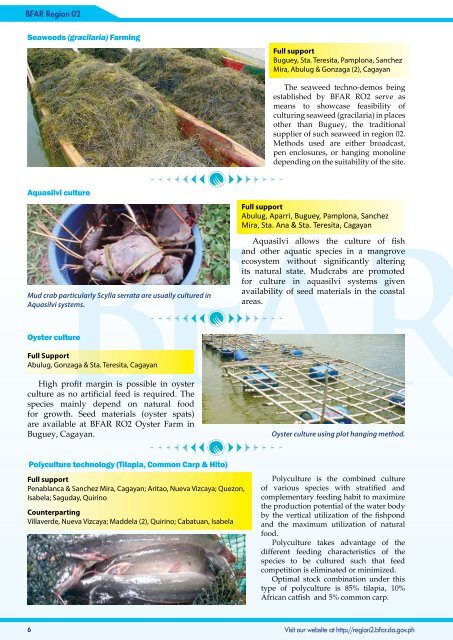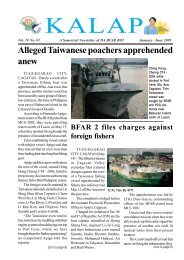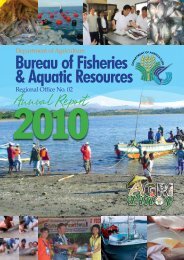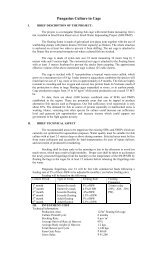Download (6668 kb ) - Bureau of Fisheries and Aquatic Resources ...
Download (6668 kb ) - Bureau of Fisheries and Aquatic Resources ...
Download (6668 kb ) - Bureau of Fisheries and Aquatic Resources ...
You also want an ePaper? Increase the reach of your titles
YUMPU automatically turns print PDFs into web optimized ePapers that Google loves.
BFAR Region 02<br />
Seaweeds (gracilaria) Farming<br />
Aquasilvi culture<br />
6<br />
BFAR<br />
Mud crab particularly Scylla serrata are usually cultured in<br />
Aquasilvi systems.<br />
Oyster culture<br />
Full Support<br />
Abulug, Gonzaga & Sta. Teresita, Cagayan<br />
High pr<strong>of</strong>i t margin is possible in oyster<br />
culture as no artifi cial feed is required. The<br />
species mainly depend on natural food<br />
for growth. Seed materials (oyster spats)<br />
are available at BFAR RO2 Oyster Farm in<br />
Buguey, Cagayan.<br />
Polyculture technology (Tilapia, Common Carp & Hito)<br />
Full support<br />
Penablanca & Sanchez Mira, Cagayan; Aritao, Nueva Vizcaya; Quezon,<br />
Isabela; Saguday, Quirino<br />
Counterparting<br />
Villaverde, Nueva Vizcaya; Maddela (2), Quirino; Cabatuan, Isabela<br />
Full support<br />
Buguey, Sta. Teresita, Pamplona, Sanchez<br />
Mira, Abulug & Gonzaga (2), Cagayan<br />
The seaweed techno-demos being<br />
established by BFAR RO2 serve as<br />
means to showcase feasibility <strong>of</strong><br />
culturing seaweed (gracilaria) in places<br />
other than Buguey, the traditional<br />
supplier <strong>of</strong> such seaweed in region 02.<br />
Methods used are either broadcast,<br />
pen enclosures, or hanging monoline<br />
depending on the suitability <strong>of</strong> the site.<br />
Full support<br />
Abulug, Aparri, Buguey, Pamplona, Sanchez<br />
Mira, Sta. Ana & Sta. Teresita, Cagayan<br />
Aquasilvi allows the culture <strong>of</strong> fi sh<br />
<strong>and</strong> other aquatic species in a mangrove<br />
ecosystem without signifi cantly altering<br />
its natural state. Mudcrabs are promoted<br />
for culture in aquasilvi systems given<br />
availability <strong>of</strong> seed materials in the coastal<br />
areas.<br />
Oyster culture using plot hanging method.<br />
Polyculture is the combined culture<br />
<strong>of</strong> various species with stratifi ed <strong>and</strong><br />
complementary feeding habit to maximize<br />
the production potential <strong>of</strong> the water body<br />
by the vertical utilization <strong>of</strong> the fi shpond<br />
<strong>and</strong> the maximum utilization <strong>of</strong> natural<br />
food.<br />
Polyculture takes advantage <strong>of</strong> the<br />
different feeding characteristics <strong>of</strong> the<br />
species to be cultured such that feed<br />
competition is eliminated or minimized.<br />
Optimal stock combination under this<br />
type <strong>of</strong> polyculture is 85% tilapia, 10%<br />
African catfi sh <strong>and</strong> 5% common carp.<br />
Visit our website at http://region2.bfar.da.gov.ph






